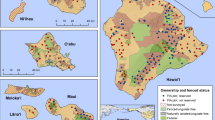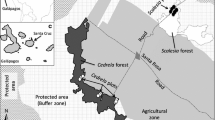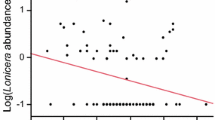Abstract
While biological invasions have been the subject of considerable attention both historically and recently, the factors controlling the susceptibility of communities to plant invasions remain controversial. We surveyed 44 sites in southeastern New York State to examine the relationships between plant community characteristics, soil characteristics, and nonnative plant invasion. Soil nitrogen mineralization and nitrification rates were strongly related to the degree of site invasion (F= 30.2, P < 0.0001 and F= 11.8, P < 0.005, respectively), and leaf C : N ratios were negatively correlated with invasion (R 2= 0.22, P < 0.0001). More surprisingly, there was a strong positive relationship between soil calcium levels and the degree of site invasion (partial r= 0.70, P < 0.01), and there were also positive relationships between invasion and soil magnesium and phosphorus. We found, in addition, a positive factor-ceiling relationship between native species diversity and invasive species diversity. This positive relationship between native and invasive diversity contradicts earlier hypotheses concerning the relationships between species diversity and invasion, but supports some recent findings. Cluster analysis distinguished two broad forest community types at our sites: pine barrens and mixed hardwood communities. Invaders were significantly more abundant in mixed hardwood than in pine barrens communities (Mann–Whitney U = 682.5, P < 0.0001). Even when evaluating the mixed hardwood communities alone, invasion remained significantly positively correlated with soil fertility (calcium, magnesium, and net nitrogen mineralization rates). Soil texture and pH were not useful predictors of the degree to which forests were invaded. Nitrogen and calcium are critical components of plant development, and species better able to take advantage of increased nutrient availability may out-perform others at sites with higher nutrient levels. These results have implications for areas such as the eastern United States, where anthropogenic changes in the availability of nitrogen and calcium are affecting many plant communities.
Similar content being viewed by others
Reference
Aber J, McDowell W, Nadelhoffer K, Magill A, Berntson Glenn, Kamakea M, McNulty S, Currie W, Rustad L and Fernandez I (1998) Nitrogen saturation in temperate forest ecosystems. Bioscience 48:921–934
Baker HG and Stebbins GL (eds) (1965) The Genetics of Colonizing Species. Academic Press, New York, 588 pp
Baker HG, Mooney HA and Drake JA (1986) Ecology of Biological Invasions of North America and Hawaii. Springer-Verlag, New York, 321 pp
Bran-Luebbe Analyzing Technologies (1986a) Ammonia in water and wastewater. Industrial Method No. 786-86T. Bran-Luebbe Inc, Buffalo Grove, Illinois
Bran-Luebbe Analyzing Technologies (1986b) Nitrate. Indus-trial Method No. 782-86T. Bran-Luebbe Inc., Buffalo Grove, Illinois
Brown RL and Peet RK (2003) Diversity and invasibility of southern Appalachian plant communities. Ecology 84:32–39
Buell MF and Cantlon JE (1950) A study of two communities of the New Jersey pine barrens and comparison of meth-ods. Ecology 31:567–586
Cade BS, Terrell JW and Schroeder RL (1999) Estimating effects of limiting factors with regression quantiles. Ecology 80:311–323
Chapin FS (1980) The mineral nutrition of wild plants. Annual Review of Ecology and Systematics 11:233–260
Crawley MJ, Brown SL, Heard MS and Edwards GR (1999) Invasion-resistance in experimental grassland communities: species richness or species identity? Ecology Letters 2:140–148
Drake JA (1989) Biological invasions: a global perspective. Published on behalf of the Scientific Committee on Prob-lems of the Environment (SCOPE) of the International Council of Scientific Unions (ICSU) by John Wiley and Sons, Ltd., Chichester, New York, 525 pp
Driscoll CT, Lawrence GB, Bulget AJ, Butler TJ, Cronan CS, Eager C, Lambert KF, Likens GE, Stoddard JL and Weathers KC (2001) Acidic deposition in the Northeastern United States:sources and inputs, ecosystems effects, and management strategies. BioScience 51:180–198
Dukes JS (2002) Species composition and diversity affect grassland susceptibility and response to invasion. Ecologi-cal Applications 12:602–617
Dukes JS and Mooney HA (1999) Does global change increase the success of biological invaders? Trends in Ecol-ogy and Evolution 14:135–139
Elton CS (1958) The Ecology of Invasions by Animals and Plants. Methuen and Co., London, 181 pp
Evans RD, Rimer R, Sperry L and Belnap J (2001) Exotic plant invasion alters nitrogen dynamics in an arid grass-land. Ecological Applications 11:1301–1310
Firbank LG and Watkinson AR (1987) On the analysis of competition at the level of the individual plant. Oecologia 71:308–317
Gleason HA and Cronquist A (1991) Manual of Vascular Plants of Northeastern United States and Adjacent Canada, 2nd edn. The New York Botanical Garden, New York, 910 pp
Goldberg DE (1987) Neighborhood competition in an old-eld plant community. Ecology 68:1211–1223
Gordon AM, Tallas M and Van Cleve K (1987) Soil incuba-tions in polyethylene bags:effect of bag thickness and tem-perature on nitrogen transformations and CO2 permeability. Canadian Journal of Science 67:65–75
Hepler PK and Wayne RO (1985) Calcium and plant develop-ment. Annual Review of Plant Physiology 36:397–439
Higgins SI and Richardson DM (1996) A review of models of alien plant spread. Ecological Modelling 87:249–265
Higgins SI, Richardson DM and Cowling RM (1996) Model-ing invasive plant spread:the role of plant–environment interactions and model structure. Ecology 77:2043–2054
Huenneke LF, Hamburg SP, Koide R, Mooney HA and Vitousek PM (1990) Effects of soil resources on plant inva-sion and community structure in Californian serpentine grassland. Ecology 71:478–491
Johnson CE, Driscoll CT, Siccama TG and Likens GE (2000) Elementffuxes and landscape position in a northern Hard-wood forest watershed ecosystem. Ecosystems 3:159–84
Kalkhan M and Stohlgren TJ (2000) Using multi-scale sam-pling and spatial cross-correlation to investigate patterns of plant species richness. Environmental Monitoring and Assessment 64:591–605
Koenker R (2002) The Quantreg Package Ver. 3. 11. Retrieved from http://www.econ.uiuc.edu/~roger/research/rq/rq. html
Koenker R and Bassett G (1978) Regression quantiles. Eco-nometrica 46:33–50
Koenker R and Hallock KF (2001) Quantile regression. Jour-nal of Economic Perspectives 15:143–156
Lawrence GB, David MB, Lovett GM, Murdoch PS, Burns DA, Stoddard JL, Baldigo BP, Porter JH and Thompson AW (1999) Soil calcium status and the response of stream chemistry to changing acidic deposition rates. Ecological Applications 9:1059–1072
Levine JM (2000) Species diversity and biological invasions: relating local process to community pattern. Science 288: 852–854
Levine JM and D'Antonio CM (1999) Elton revisited: a review of evidence linking diversity and invasibility. Oikos 87:15–26
Likens GE, Driscoll CT, Buso DC, Siccama TG, Johnson CE, Lovett GM, Fahey TJ, Reiners WA, Ryan DF, Martin CW and Bailey SW (1998) The biogeochemistry of calcium at Hubbard Brook. Biogeochemistry 41:89–173
Lonsdale WM (1999) Global patterns of plant invasions and the concept of invasibility. Ecology 80:1522–1536
Meekins JF and McCarthy BC (2001) Effect of environmental variation on the invasive success of a nonindigenous forest herb. Ecological Applications 11:1336–1348
Morrison SL and Molofsky J (1998) Effects of genotypes, soil moisture, and competition on the growth of an invasive grass, Phalaris arundinacea (Reed Canary Grass). Cana-dian Journal of Botany 76:1939–1946
Pimm SL and Lawton JH (1991) Food web patterns and their consequences. Nature 350:669–675
Reich PB, Abrams MD, Ellsworth DS, Kruger EL and Tabone TJ (1990) Fire affects ecophysiology and commu-nity dynamics of central Wisconsin oak forest regeneration. Ecology 71:2179–2190
Reich PB, Ellsworth DS and Uhl C (1995) Leaf carbon and nutrient assimilation and conservation in species of differ-ing successional status in an oligotrophic Amazonian for-est. Functional Ecology 9:65–76
Reichard SH and White P (2001) Horticulture as a pathway of invasive plant introductions in the United States. Bio-Science 51:103–113
Rejmanek M and Richardson DM (1996) What attributes make some plant species more invasive? Ecology 77:1655–1661
Ricciardi A, Steiner WWM, Mack R and Simberloff D (2000) Toward a global information system for invasive species. BioScience 50:239–244
Robinson GR, Quinn JF and Stanton ML (1995) Invasibility of experimental habitat islands in a California winter annual grassland. Ecology 76:786–794
Scheiner SM (1993) MANOVA: multiple response variables and multispecies interactions. In: Scheiner WR and Gure-vitch J (eds) Design and Analysis of Ecological Experi-ments, pp 94–112. Chapman &Hall, New York
Shaver GR and Chapin FSI (1991) Production:biomass rela-tionships and element cycling in contrasting arctic vegeta-tion types. Ecological Monographs 61:1–31
Smith MD and Knapp AK (1999) Exotic plant species in a C-4-dominated grassland:invasibility, disturbance, and community structure. Oecologia 120:605–612
Sokal RR and Rohlf FJ (1995) Biometry:The Principles and Practice of Statistics in Biological Research, 3rd edn. W. H. Freeman, New York, 887 pp
Stohlgren TJ, Bull K, Otsuki Y, Villa C and Lee M (1998) Riparian zones as havens for exotic plant species in the central grasslands. Plant Ecology 138:113–125
Stohlgren TJ, Binkley D, Chong GW, Kalkhan MA, Schell LD, Bull KA, Otsuki Y, Newman G, Bashkin M and Son Y (1999) Exotic plant species invade hot spots of native plant Diversity. Ecological Monographs 69:25–46
Symstad AJ (2000) A test of the effects of functional group richness and composition on grassland invasibility. Ecology 81:99–109
Thomson JD, Weiblen G, Thomson BA, Alfaro S and Legendre P (1996) Untangling multiple factors in spatial distributions: lilies, gophers, and rocks. Ecology 77:1698–1715
Tilman D, Knops J, Wedin D, Reich P, Ritchie M and Siemann E (1997) The inffuence of functional diversity and composition on ecosystem processes. Science 277:1300–1302
Vitousek PM (1990) Biological invasions and ecosystem pro-cesses: towards an integration of population biology and ecosystem studies. Oikos 57:7–13
Vitousek PM, Loope LL and Stone CP (1987) Introduced species in Hawaii: biological effects and opportunities for ecological research. Trends in Ecology and Evolution 2: 224–227
Williamson J and Harrison S (2002) Biotic and abiotic limits to the spread of exotic revegetation species. Ecological Applications 12:40–51
Williamson M (1996) Biological Invasions. Chapman & Hall, London, UK
Wiser SK, Allen RB, Clinton PW and Platt KH (1998) Com-munity structure and forest invasion by an exotic herb over 23 years. Ecology 79:2071–2081
Woo I and Zedler JB (2002) Can nutrients alone shift a sedge meadow towards dominance by the invasive Typha x glauca? Wetlands 22:509–521
Author information
Authors and Affiliations
Corresponding author
Rights and permissions
About this article
Cite this article
Howard, T.G., Gurevitch, J., Hyatt, L. et al. Forest Invasibility in Communities in Southeastern New York. Biological Invasions 6, 393–410 (2004). https://doi.org/10.1023/B:BINV.0000041559.67560.7e
Issue Date:
DOI: https://doi.org/10.1023/B:BINV.0000041559.67560.7e




